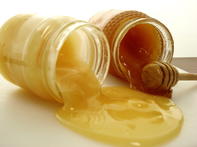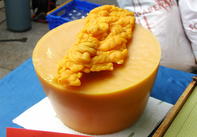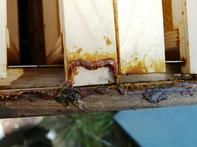Apitherapy is essentially 'bee therapy' and is the use of bee products for the treatment and prevention of diseases. According to the American Apitherapy Society, these bee-related products include honey, pollen, propolis, royal jelly and bee venom.

Pollen as a Supplement for Humans
The use of pollen as a supplement for human health and even for medicinal purposes is controversial. Bee pollen available at health food stores is collected by a beekeeper with a pollen trap. This scrapes the pollen off the bee’s legs as the bee enters the hive. Therefore, reducing pollen available for bees to feed their young.
Little research has been done on the nutritional value of raw pollen for use in human food/nutritional application, yet pollen is widely used for therapeutic properties such as anti-inflammatory and anticancer. Turkish studies (in vitro) have shown bee pollen to have an antibacterial activity that can improve resistance to infection.
The United State’s Food and Drug Administration (FDA) stated that ‘pollen is not the richest source of protein known to science. The major constituent of pollen is carbohydrates (over 60%), not protein - varying according to the source of pollen.’ The nutritional value of pollen is often evaluated by its concentration of protein and essential amino acids.
Some types of pollen may be highly nutritious, while others less so. The Apis Information Resource Centre says when compared to supplements such as vitamin/mineral tablets, pollen contains much lower levels of these micronutrients than the supplements … (and) should not replace good dietary and health practices.
Potential contamination of pollen with heavy metals or pesticides could be another concern for human consumers of pollen and pollen-related products.
Bee Bread as Supplement for Humans
Bee bread is manufactured by bees using pollen, nectar, digestive enzymes and honey. The mix is then sealed into a cell to ferment. The fermentation process breaks down proteins and starches and makes vitamins more bio-available.
The resulting ‘bee bread’ is fed to larvae and young bees as a protein-rich feed. Bee bread has a different (and more improved) nutritional composition compared to raw pollen and is better digested by the human body.
Beeswax as Medicine

In 400 BC Hippocrates, an ancient Greek doctor, confirmed the advantages of beeswax to relieve skin diseases. Beeswax is used more extensively in modern medicine.
Secreted in the form of scales by young worker bees, beeswax is used in the coatings of medications and is used, for example, in skin creams, soaps, in earplugs for noise, in dental surgery and in sutures to control bleeding during bone surgery.
Royal Jelly - Fantastic of Fad?
Royal jelly is a white paste-like secretion from the ‘mouth glands’ of worker bees and is fed to larvae and the queen bee. The main use of use of royal jelly is in cosmetics but it is also used as a dietary supplement. Royal jelly can be sold fresh, mixed with other products such as yoghurt or freeze-dried. It has a pungent odour, sour taste and the consistency of a fairly fluid paste.
Based on the longevity and fertility of the queen bee, the assumption has been made that royal jelly could have similar beneficial properties for humans. This assumption could, despite numerous research studies, not be confirmed.
Many studies of the effects of royal jelly on humans have been done, especially in Eastern Europe, but most studies are difficult to evaluate for the scientific value of the results.
However, a Japanese trial showed improved glucose tolerance and mental health and an increase in the manufacture of red blood cells. In vitro studies found that royal jelly has antibiotic activity but this decreases with improper or long-term storage.
Propolis as Medicine

Propolis is a sticky ‘bee glue’ made by bees from tree resins and is used inside the beehive to smooth the inside of the hive, seal cracks and sterilise. Also known as 'Russian penicillin', propolis is used in many countries where antibiotics are not widely available. It has antioxidant, antibacterial, antiviral, anti-fungal, anti-tumour and anti-inflammatory properties.
It is used to prevent the infection of wounds, heal mouth and gum sores, renew cartilage tissue, reduce inflammation inside the veins and treat ulcers, according to Polish and German studies. Propolis is also used to heal bed-sores as well as chemical, heat and radiation burns.
Bee Venom as an Anti-inflammatory
Honey bee venom is a clear bitter, colourless liquid which contains a mixture of proteins causing local inflammation and acts as a blood thinner. Used for centuries, it is particularly popular in China and Eastern Europe today where it is mainly used for chronic inflammatory disease.
It can be injected or used as a cream to reduce inflammation in ailments such as arthritis, multiple sclerosis (MS), lower back pain and tennis elbow. Bee venom is extracted by passing an electric current through a mesh placed inside the hive.
This agitates the bees, causing it to sting the mesh, from where the venom is then collected. Bees are not harmed during this process.